Staples of the modern home kitchen, Crock-Pots and rice cookers are time-savers, enabling chefs to prepare long-cooking meals without tending the stove for hours. But theres another way to slow-cook foods, one thats easily portable and doesn’t require a constant electrical source: retained-heat cooking.
Retained-heat (thermal) cooking is the practice of heating a pot to boiling, simmering for just a few minutes, and then placing the pot in a well-insulated container to finish cooking with the heat the pot and contents already have. Thermal cooking is great for cooking stews, casseroles, soups, desserts, and other dishes. Not only do thermal cookers save on cooking fuel or electricity and time, they also make it possible to cook underway without constant stove tending (so long as the cookers are properly secured), which is great for short-handed crews, and the reduced stovetop-cooking time means the cabin isn’t turned into a sauna. Cooking with retained heat also means you can prep a meal before getting underway, leave it to cook while sailing, and then enjoy it later-either once the anchor is dropped or when the night watch begins. You can also prep a meal and leave to explore town without concern about an untended flame or burned meal.
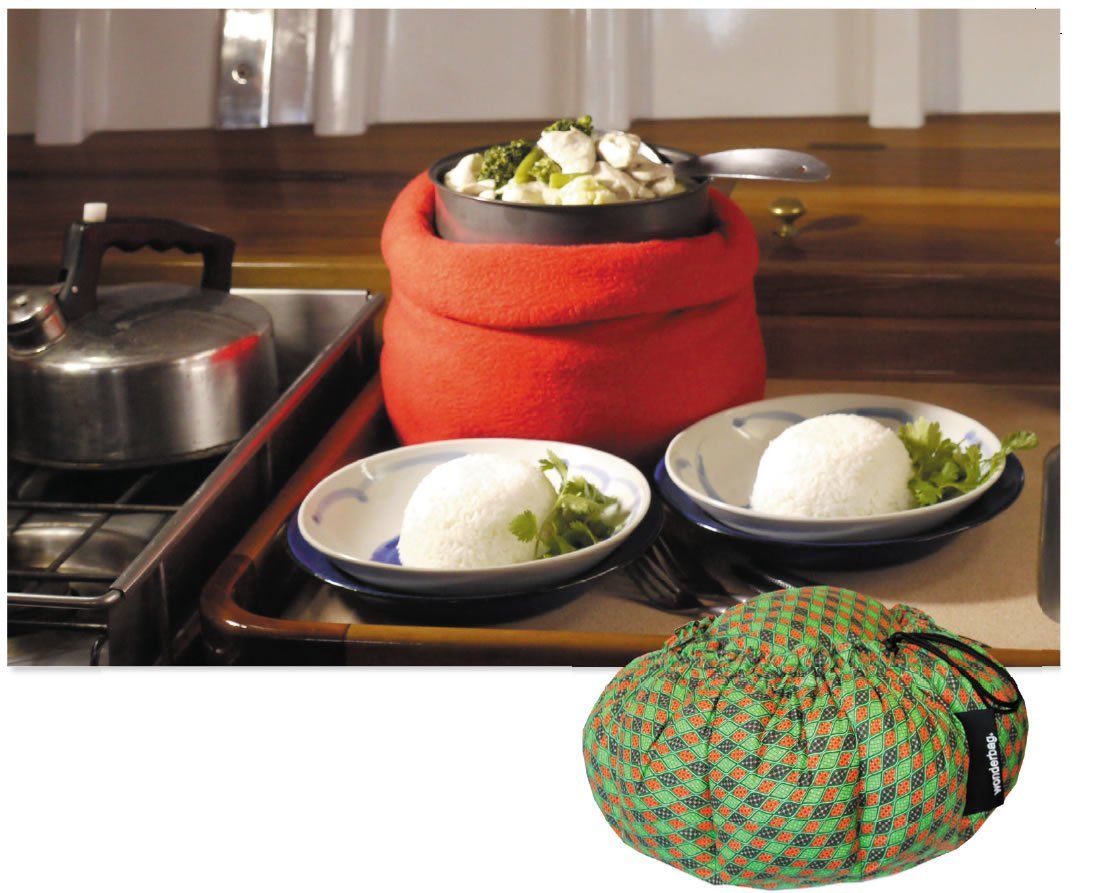
For retained-heat cooking, the container can be as simple as a box packed with straw-common on sailing ships of old and in 19th- and early 20th-century kitchens-or something more modern. Many designs have been introduced: insulated fabric bags, a basket lined with fleece blankets, plastic devices similar to drink coolers, and stainless-steel, vacuum-insulated pots. We decided to give a few devices-commercial fabric bags, vacuum-insulated containers, and homemade setups using common household gear-a try to see which of the energy-saving, time-saving designs is the best option for galley service.
What We Tested
We tested two commercial fabric bags, the Heylo Bag and the Wonderbag; both are washable fabric bags filled with foam beads. Testers also evaluated the Tiger Corp. Magic Cooker, which comprises a vacuum-insulated container and fitted pan that slides into the container. The homemade setups we tested included a common drink cooler, a vacuum-insulated Coleman Steel Belted thermos, a sleeping bag, and a wood basket full of fleece blankets.
Each commercially available product came with a starter recipe book, and many more recipes can be found on the Internet by searching retained heat cooking.
How We Tested
To evaluate insulation efficiency, testers placed pots of boiling water (4-quarts in a 6-quart pot and 1-quart in a 2-quart pot) in each cooker and measured the temperature at time intervals: one, two, four, and eight hours.
For all but the Tiger Cooker and Coleman stainless cooler, we wrapped the pot in a 4-foot by x 4-foot fleece blanket to protect the cooker insulation from peak temperatures and to keep the cooker clean.
To reduce heat escaping, testers took quick temperature measurements using an infrared thermometer. The thermometer read true at boiling (212 degrees), and we were always able to open and reseal the cookers in seconds. We repeated the tests, skipping some time intervals, to establish that the heat lost while peeking did not affect later time periods.
To gauge ease of use and performance, testers also cooked many meals in each device, including simple staples like rice and potatoes, as well as stews and soups. Price, availability, warranty and stowage ease also were considered.
We compared the performances of all to that of an electric Crock-Pot (model SCCPVL605-B-A) and the Thermos Shuttle Chef thermal cooker, which we reviewed in the September 2012 issue and is similar in design to the Tiger Magic.
While thermal cookers cool down during the cooking cycle, Crock-Pots spend the first two hours heating up. Their power consumption is significant but not show-stopping: 12 to 20 amp-hours during a typical four-hour cooking cycle (250 watts on high at the start and then 100 watts for the remaining time). Using a Crock-Pot saves the time spent waiting for the pot to boil, but cleaning the crock itself is generally more difficult, and its not very good for cooking rice. Crock-Pots also are bulky and heavy, which can make them dangerous if used underway and can be a challenge to stow.
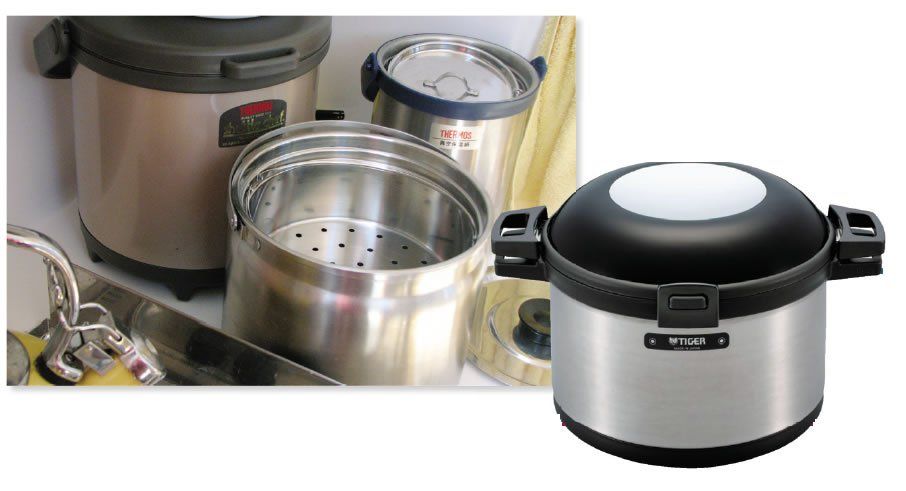
Observations
Overall, we were pleasantly surprised by the cookers effectiveness and the amount of stove time and cooking fuel that was saved. While only the more efficient cookers retained adequate heat in smaller pots for meals requiring long cooking times, all could cook rice in a smaller container and all could cook potatoes and stews in a larger batch. In general, a 1-quart-full pot cooled about twice as fast as a pot with 4 quarts of contents; the smaller amount has a quarter of the thermal mass, but only half of the surface area to lose heat.
Perhaps the most impressive piece of test data was that among the recommended retained-heat cooking devices, the four-hour average temperatures and the eight-hour average temperatures (with large batches) were actually higher than that of our Crock-Pot, solid proof of their cooking effectiveness. With smaller batches, the four-hour temperatures were still higher than those of the Crock-Pot, and although there was some cooling in the following four hours, the retained-heat cookers averages were very similar to the Crock-Pots, and the result was the same.
We found some cookers to be far more convenient in use. The sleeping bag worked, but was the most difficult to open and close and the least stable. The Heylo Bag and Wonderbag were easier to store and to use on a boat. The vacuum-bottle cookers like the Tiger were more stable and spillproof-a bonus for underway use. But for the sailor wanting to test out the idea before buying something, blankets in a basket are effective and you likely have the items on hand.
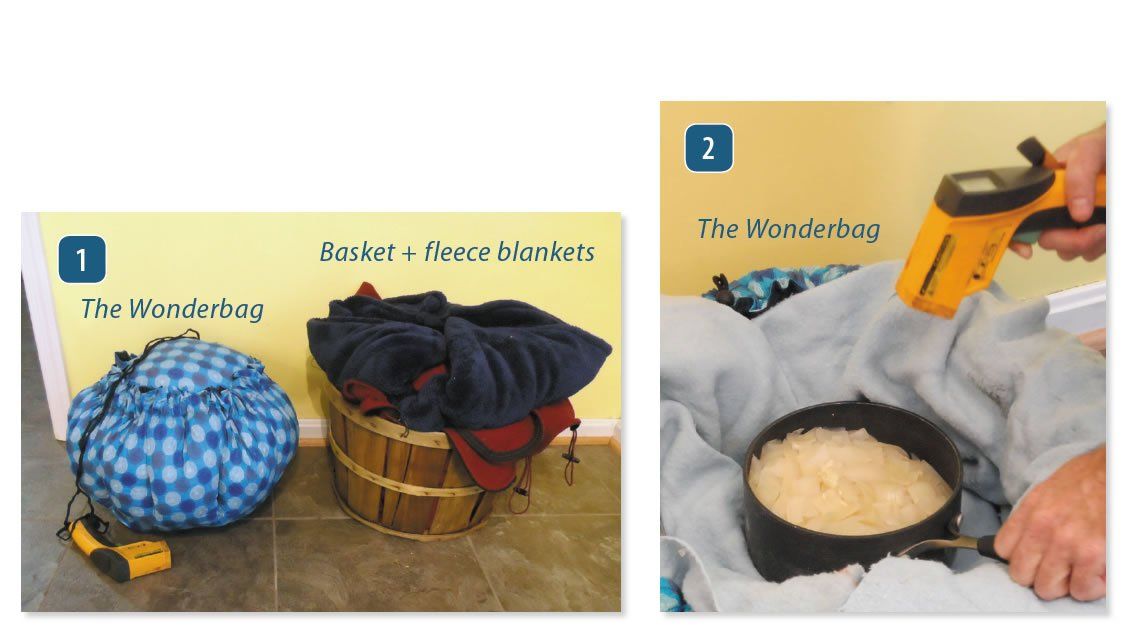
Fabric-bag Cookers
Wonderbag
The Wonderbag, which has seen a surge of popularity in the cruising community, is a delightful merging of low-tech and modern materials that punches all of the right design requirements for a sailor. The recycled-foam insulation is highly efficient and durable, has low thermal mass, and conforms to any shape pot. The puffy, cotton cover wraps around all pot shapes and sizes, offers even insulation distribution, eliminates cold spots, and is washable. It easily mashes into odd storage spaces, and it is stable if wedged somewhere on the cabin sole. The bags come vacuum-packed and require 15 minutes or so of vigorous kneading to re-fluff.
Bottom line: Versatility and efficiency make the Wonderbag the best fabric bag choice, especially for small pots. Available in a number or sizes and styles, the cooker sells for about $50-$70, and with each bag purchased, one is donated to a third-world community. A pot-filled Wonderbag likely wont fit in your galley sink, so be sure you have a secure place to put it during use to avoid scalding spills and steaming missiles.
Heylo Bag
Very similar in concept and design to the Wonderbag, the Heylo Bag is made of polyester fleece inside and out, rather than cotton. The Heylo does not accommodate as large of a range of pot sizes as the Wonderbag, but it is handier to use pots that have handles, and it is smaller to store. Made in and shipped from New Zealand, the Heylo comes in two sizes (small and large) and runs $31 to $38, plus shipping ($18-$24 to the U.S. or worldwide).
Bottom line: Because of its compact size and convenience, we Recommend the Heylo for smaller galleys.
Vacuum cookers
Tiger Magic Cooker
Considered to be among the best in its category, the 6-liter Tiger Thermal Magic Cooker (NFI-A600) system is a stainless pot that fits inside a stainless-steel vacuum bottle that is sealed with an insulated lid. The food can be heated inside the supplied pot, but this limits the pot-size choice. However, testers found the compact Tiger countertop system to be the easiest to use and safest against spills thanks to its locking lid, but priced at $275, it is also the most expensive choice. The 4.5-liter model, suitable for one or two people, is $175.
Bottom line: The Tiger is the Best Choice for those who will use it often enough to justify the hefty pricetag.
Coleman Steel-belted thermos
Another take on the vacuum-insulated approach is to simply pour a heated meal into a wide-mouth, vacuum bottle thermos. (Not all beverage coolers are suitable for hot liquids-check the specifications.) This can be awkward for rice or lumpy meals, but testers found it quite suitable for soups, though it does make one more dish to wash.
Bottom line: Vacuum-insulated drink thermoses like the Coleman steel-belted bottle are bulky and small-capacity, but they can function as retained-heat cooking containers. And since most sailors already have one, this is an inexpensive option. If you have one, try it.
Thermos Shuttle Chef
Practical Sailor reviewed the 4.5-liter, double-walled Thermos Shuttle Chef thermal cooker in the September 2012 issue. Although we did not re-test this products heat-retention properties for this report, wed expect it to perform much like the Tiger Thermal Magic Cooker. The PS tester who has been long-term testing the Shuttle Chef since our initial review reports that it is still performing well, is easy, safe, and convenient to use (even underway), and is comparable to other vacuum-insulated, Crock-Pot-style thermal cookers with locking lids.
We found the 4.5-liter Shuttle Chef online for $186 to $285.
Bottom line: PS recommends the Shuttle Chef for those willing to invest in this type of cooking tool. Its another excellent option for liveaboards and bluewater cruisers who will use it often.
Homemade Cookers
Sleeping Bag
For this test, we used a North Face Cats Meow sleeping bag, which features synthetic insulation and is rated for use in 20-degree weather. While it was efficient in maintaining heat, the sleeping bag never felt stable during onboard field trials, and we lived in fear of food spilling into it (its very difficult to launder). In fact, not wanting our sleeping bag to smell of beef stew (bears love that), we tested only hot water in the setup.
Bottom line: Cooking with a sleeping bag was interesting to test, but it turned out not to be a very handy option.
Basket of Fleece
To create our basket-o-fleece cooker, we used a simple bushel crab basket (one we had salvaged from a beach, varnished, and use to store rope in) and two, standard-weight, queen-sized fleece blankets. The blanket selection was important: Heavy blankets (wool, quilts) require too much heat to warm, and other users have reported poor results using them. We folded the fleece blankets into quarters to line the basket, placed a pot-sized circle of 1-inch polyurethane foam (from a mattress topper) in the bottom, and then topped the cooking pot with a smaller fleece lap blanket folded into eighths. We then folded the tails of the liner blankets over the pot sides and the top of the lap blanket. This easy, do-it-yourself setup proved very handy and effective.
Bottom line: This DIY rig is the PS Budget Buy. It is a good option for those considering a commercial product, but it would be a bit cumbersome for regular use; spills were a concern.
Coleman coolers
For testing, we used 40-quart and 20-quart Coleman-brand drink coolers. We were surprised by this methods effectiveness and simplicity; just plop the hot pot(s) into the cooler and close the lid. Two large pots will fit in the 40-quart cooler. Unfortunately, excessive air space and less efficient insulation make this approach unsuitable for use with smaller pots, and the coolers take a lot of storage space when not in use.
Bottom line: If we were asked to make a big batch of stew to-go, and needed it to be piping hot four hours later, this might be the safest way to transport it. But this isn’t the best choice for cooking regular, family-sized meals.
Conclusion
A retained-heat cooker is a useful and robust addition to both the galley and the home kitchen. In addition to the fuel/power savings and reduced time tending to the stove, you don’t have to worry about burning food with a thermal cooker; since there is no flame, overcooking seldom does any harm. Opting for thermal cooking also means less heat in the galley in the summer and less moisture and carbon dioxide in the boat in the winter. The only drawbacks are stowage, it takes longer to cook a meal, and small batches are a challenge to keep hot.
The versatile, efficient Wonderbag earned the Best Choice pick for fabric bag cookers. The Tiger Magic got the top spot for vacuumed-insulated thermal cookers, but we still highly recommend the Shuttle Chef vacuum cooker as well; both would be a good choice for passagemakers and liveaboards who would use them often. The compact Heylo is the Recommended cooking bag for those who plan to use only small pots and have minimal stowage space. Among the DIY alternatives, the bushel basket lined with fleece is the best budget-friendly option.
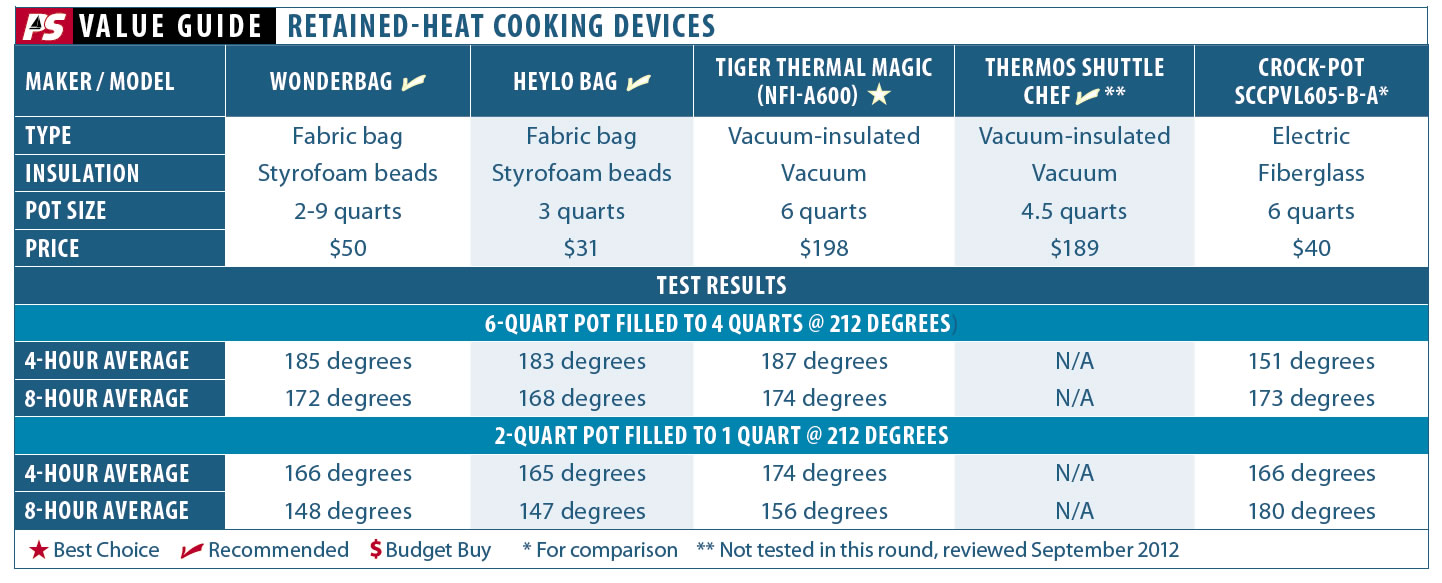
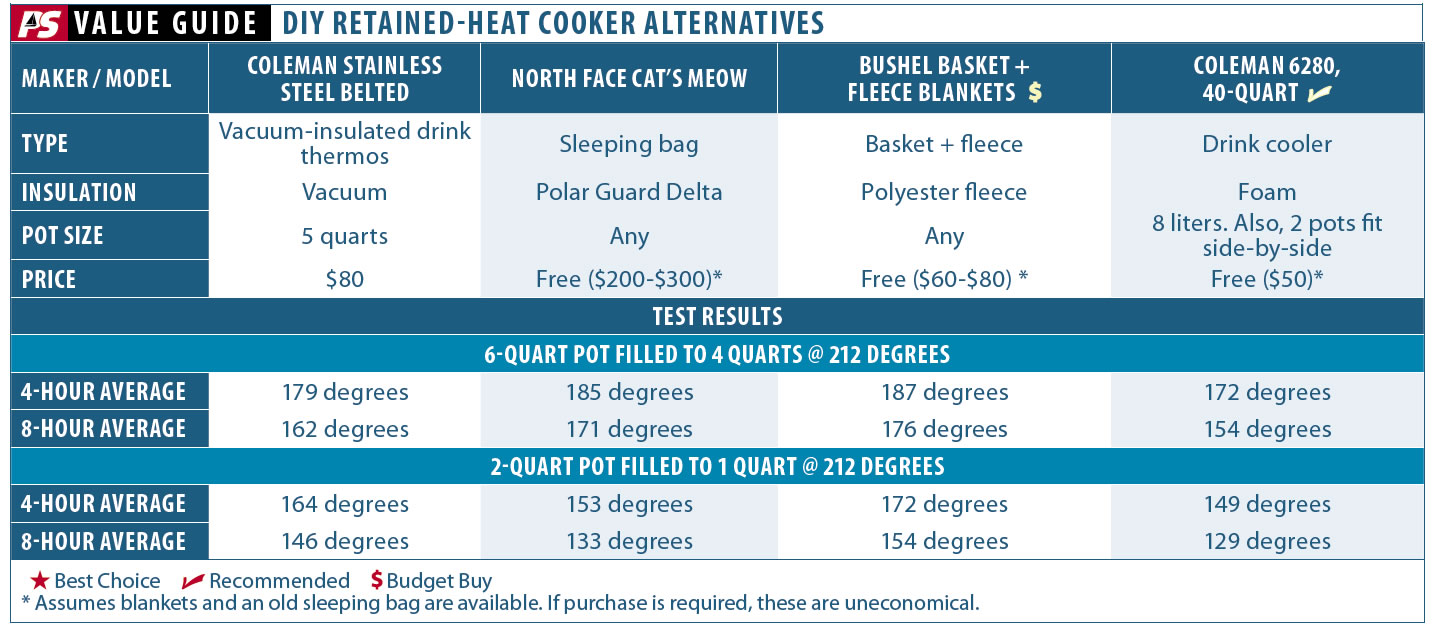





























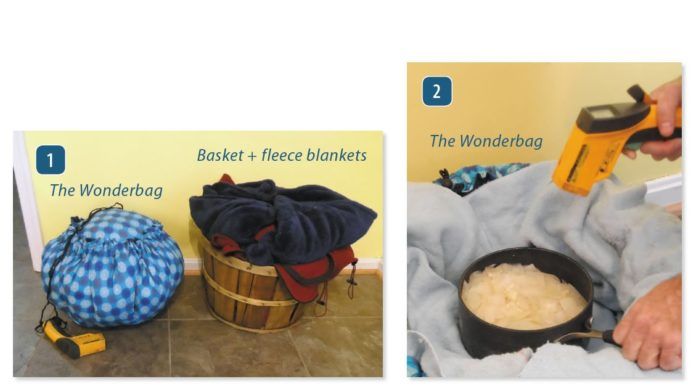




Hi – interesting but no mention of ‘Mr Ds’ or the Ecopot…?